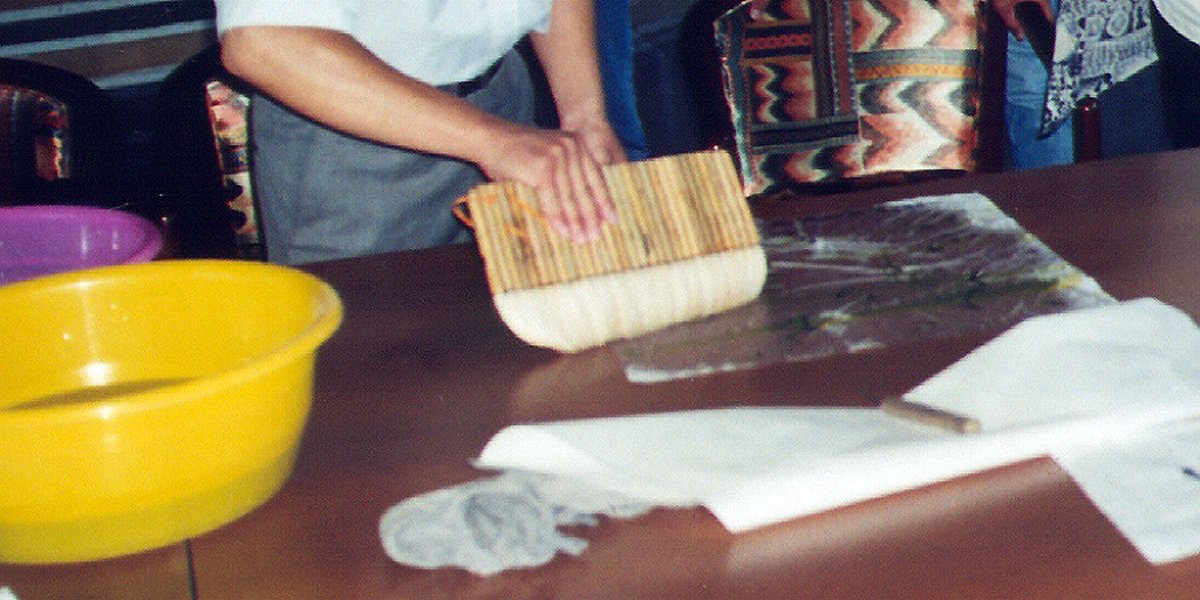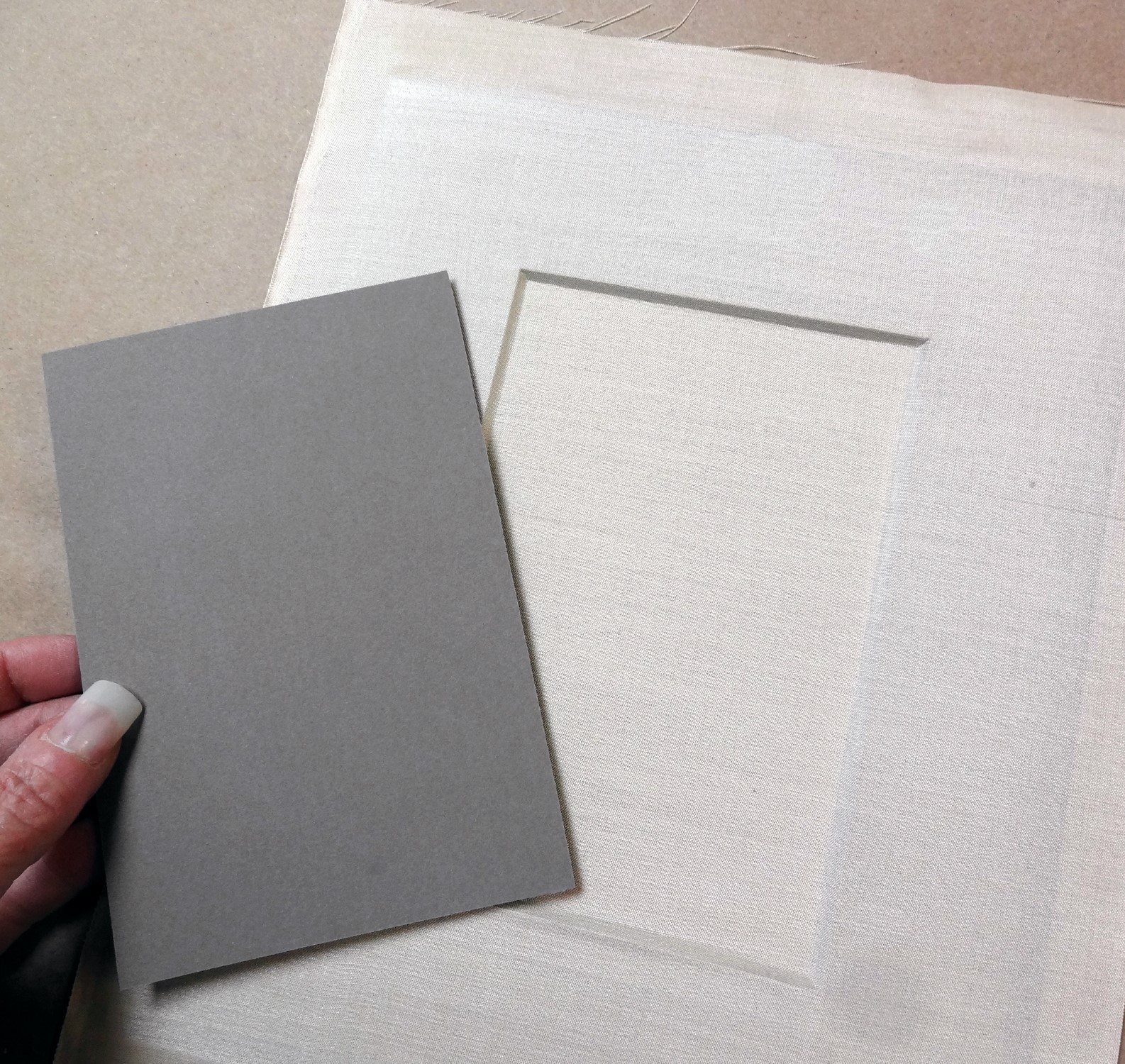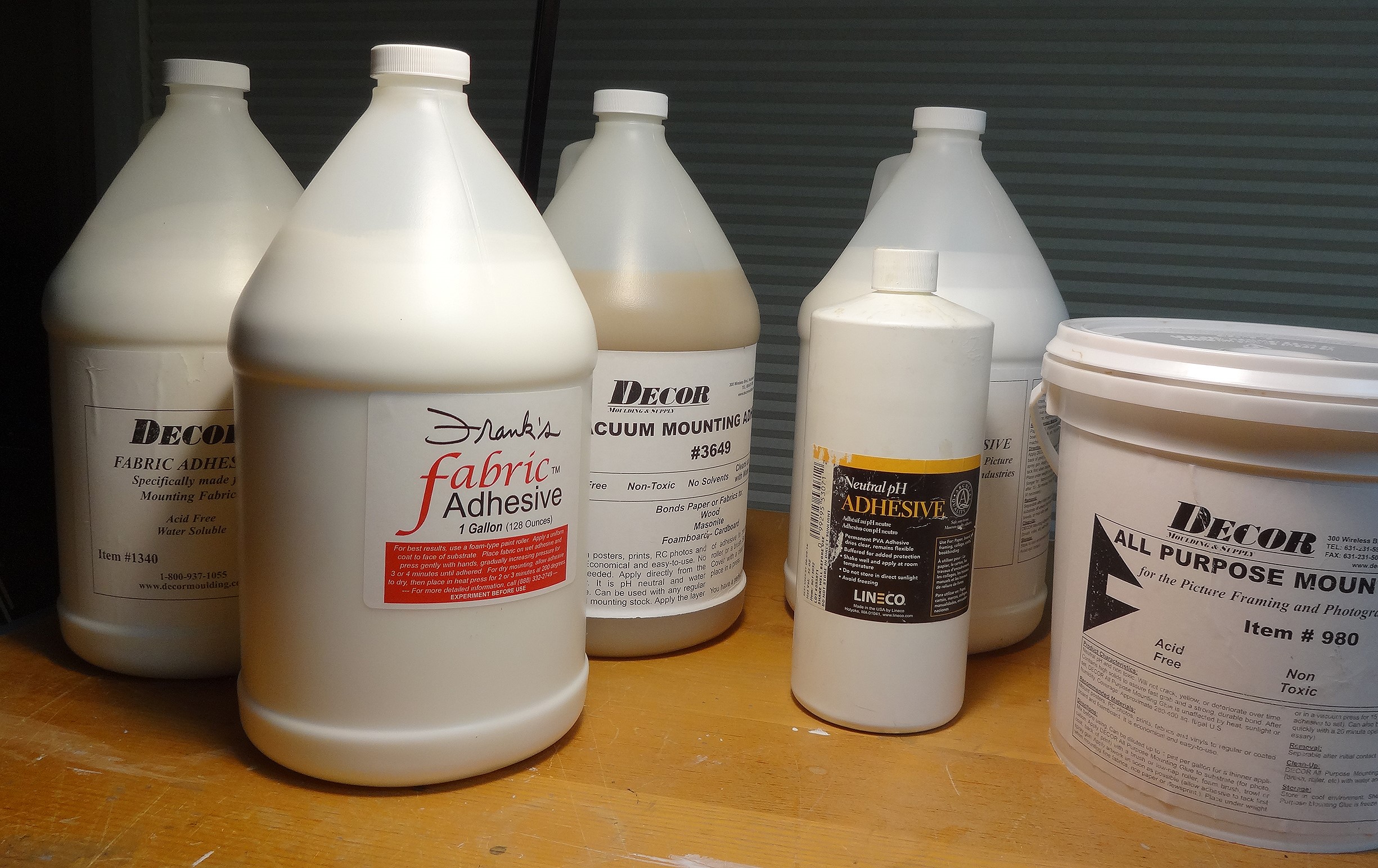 Photo 1
Photo 1
Starch paste applied with wide hake brush to adhere backing support sheet for sumi-e painting.
Since the onset of digital printing with oversized imagery, and vastly assorted printing substrates requiring mounting, I've been asked for decades if dry mounting is fading away, and my answer has always been, "no, not for our industry." But alas technology, supply chain issues and Covid may have finally altered that fact, so I am here to discuss the changes and updates of framing adhesives and mounting, from starch to dry mounting.
Starch Glues
It feels like we've come full circle from wet mounting back to wet mounting and it all began with vegetable starch. Starch glues are ones that begin curing once they begin to dry and the moisture evaporates from the adhesive solution. They are used throughout the world in numerous industrial applications from papermaking to textile manufacture. (Photo 1) Pure starch adhesives remain indefinitely swellable in water and are therefore reversible. Starches are granules present in assorted plant sources (rice, potato, wheat) that when cooked, swell and burst, creating a water-dispersed paste adhesive. Common starches are wheat, rice, and modified starches known as dextrins.
 Photo 1
Photo 1
Starch paste applied with wide hake brush to adhere backing support sheet for sumi-e painting.
A few of the most commonly known dextrin adhesives are Yes! Paste, (Seal) VacuGlue 300, and Décor Vacuum Mount Adhesive. These are dextrin, water and preservative that dry transparent, permanently flexible, and are acid free with a pH of 6.0-6.5. Though YES! Paste is a starch paste it is not generally embraced for extended-term (archival) use, nor considered reversible.
Wet Mounting
Wet mounting is the oldest method of adhering paper or fabric to a rigid backing using a wet adhesive or cooked starch paste. Commercial wet glues bond items together using liquid vinyl resin called polyvinyl acetate (PVA) which is a thermosetting adhesive that once dry does not generally reactivate with water. Traditional wet mounting with PVA remains a routine technique for fabric applications practiced by many custom framers, with wet/dry mounting—a modified mount process involving both wet application and dry mount technique—often being overlooked. (Photo 2)
 Photo 2
Photo 2
Wet/Dry technique used to dry mount sheer silk to PVA coated (dry) 8 ply rag to prevent glue bleed through.
Manual wet mounting—with no vacuum frame or rollers—requires little financial investment and is a good alternative for mounting oversized items when equipment size limitations are an issue. And based on the principles of TTPM, successful wet mounting requires an even, moist layer of adhesive (M); proper open time (T); and weighting (P) as it fully dries and cures. Glues may be applied by brush, roller, or spray gun, and when used in conjunction with a vacuum frame or roller system have more immediate bond, which may also increase long term permanency.
All Purpose PVAs including Décor 610, and Lineco Neutral pH are lighter consistency for use with paper, and RC photos. PVA Paste is heavier for posters, digital photos, fabric, and vinyl, with common brands being Décor 980 and LION 10554. Fabric PVA is a little thicker and is used for bonding fabric to matboard, liners, MDF and more rigid substrates. These include Franks Fabric Glue, Décor 1340, and Raphael Miracle Muck. (Photo 3)
 Photo 3
Photo 3
Décor Fabric Glue, Franks Fabric Adhesive, Décor 1340, Decor Vacuum Mount 3649, Lineco Neutral pH Adhesive, Décor Mounting Paste 980.
Pastes, PVA and EVA
Wet glue is a thick paste or commercial liquid adhesive which must be evenly applied to the substrate before positioning the art. Commercial pastes are available from major manufacturers that are starch based, neutral pH, nontoxic, buffered and water soluble for removal. A basic PVA wet glue is repositionable while wet, nontoxic, nonstaining with age, dries clear, and has long term bonding ability.
Jade® 403 (Book Restoration Adhesive) PVA is frequently used for book and box making applications; adhering paper to paper, cloth, wood or leather; and fabric wrapping to matboard, honeycomb panels, or Gatorboard. and framing as a general purpose, neutral pH neutral, thermoplastic adhesive which is fast drying, water-soluble when wet, and permanent when dry. On the other hand, ethylene vinyl acetate (EVA) is a water reversible formulation of modified PVA copolymer found as Jade® R (Jade® Book Restoration Adhesive). It maintains softness and flexibility, clarity and gloss, low-temperature toughness, and resistance to UV radiation. Jade R is a reversible EVA that is 7.1-7.3 pH, archival adhesive which provides a very strong bond similar to Jade 403 making it ideal for conservation work where reversibility is a concern.
Spray Mounting
Though not considered a select technique for long term frame bonding, spray mounting remains a popular option for many framers. The thing to remember is that the term permanent means it will show tear strength after curing at the time of creating the bond, but over time as the tackifiers dry out the bond begins to fail. Failure may be due to improper mounting method or fluctuations in temperature, humidity and exterior environmental elements; this is often why spray mounted posters, placed in a bathroom, may bubble and lift in a shorter time.
Controlled Tension and Dominance
A single portrait dressed in dark clothing amidst a multiple opening mat of light colored portraits will be the first photo seen. This dark shape will dominate even if all the images are the same opening dimensions. The desired end product utilizes what is known as controlled tension to direct or balance the images. Visual interest and balance must be achieved or the design is doomed to failure. Good art will already contain this necessary element, but object boxes, multiple openings, and wall groupings must be controlled by the framing designer.
Pressure-Sensitive Mounting
Thanks to the digital explosion of art, signage and everything in between, pressure-sensitive adhesives (PSAs) are fast becoming the go to for framers when they are not choosing PVA. They stick by a micro suction cup effect generated by tiny voids on the surface of the adhesive. They are soft enough in solid form to conform very closely to surfaces being bonded, and also stick by a sort of micro suction cup generated by tiny voids on the surface of the adhesive. PSAs are available as films, films with carriers, and as PS boards or with low, medium, and high tack capabilities. They are dry, easy to use, may be bonded manually, with rollers, or vacuum systems depending on the curing requirement (T/P). The warmer the materials the more aggressive the bond, and moisture is not a friend of P-S materials. (Photo 4)
 Photo 4
Photo 4
Proper mount process for manual PSA application. Fold back liner to expose adhesive, align from bottom to top, press to hold, pull release liner while following down to remove air.
Films include PMA (3M Positionable Mounting Adhesive), Gudy 870 (Gudy O - no carrier), Crescent Brands Perfect Mount (clear carrier), and Gudy 831 (Gudy V - long fiber sheer carrier). Common boards featuring pre-applied adhesives are Crescent Perfect Mount board and foamboard, Bainbridge SA (self-adhesive), Gilman SA HT (self-adhesive high tack), and KoolTack InstaMount.
Dry Mounting
The beauty of thermoplastic dry mount adhesives is they reactivate when placed back in a press allowing the bonded item to be removed from the substrate, or for premounting of tissues. Numerous thermoplastic adhesives—ones that bond by cooling—are used as rolled products for photo and art framing. Due to possible supply chain issues and/or perhaps low sales volumes over the decades many of these adhesives have been discontinued or replaced by P-S and HA matboards and foamboards.
Seal, Inc. was founded in 1936 and eventually became one of the largest manufacturers of dry mount tissues in the United States. FotoFlat® was introduced in 1938, MT5® (1953), ColorMount® (1973), Fusion® 4000 (1976), ArchivalMount(tm) (1984), now called BufferMount®. One of the most significant adhesives of its time is Fusion 4000 pure film ethylene vinyl acetate (EVA) originally used to mount photographs onto rigid substrates. It was embraced by artists, photographers and framers for decades because of its vast array of uses from clear mounting for color tinting, ghosting control, piecing together, premounting, fabric wrapping, and assisting with assorted creative applications such as stacking 4-ply matboards, tiered matting and deep bevel wrapping. Much to our dismay it has been discontinued in the past four years and replacing it has been difficult at best.
We used to identify rolled adhesives by composition—tissue-core carrier and film; type of bond—permanent vs. removable; porosity—breathable vs. non-breathable; and acidity level—buffered vs. unbuffered. We used these categories as guidelines to identify and compare manufacturer brands and generic brands as apples to apples. Though that still matters, so many people have shifted to adhesive coated (HA and P-S) boards it isn't that much of a concern anymore. Since FotoFlat, MT5, ColorMount, Fusion 4000, and Flobond, Techmount, Drychival, RagMount, and others have all been discontinued, (Drytac) Trimount, (D&K) NTMT and BufferMount, and (Décor) Permanent Dry Mount Tissue remain most available. So it is...what it is.
HA Boards
TTPM always remains important when dry mounting regardless of tissue or HA board. Time is the dwell time required to activate and create the bond, with the average vacuum press 4 min (3 minute dwell time), and mechanical press 1-2 min dwell time. Temperatures run between 130°F-190°F and it is imperative to use the correct time and temperature. Pressure is the force that compresses air from between bonding layers. A mechanical press is manually set; a vacuum press automatically adjusts for pressure and draws moisture out automatically. Predrying is required in a mechanical press. (Photo 5)
 Photo 5
Photo 5
Proper mechanical press adjustment is required to maintain control the mounting elements time, temperature, pressure, moisture (TTPM).
Individual HA boards indicate their own time and temperature, but still requite TTPM attention. Boards are available as reversible, leaving no sign of adhesive absorption once removed; removable, reactivates with heat but leaves adhesive saturation once removed; and and permanent, only removes with chemical assistance, leaving adhesive residue. Popular HA boards include Kool Tack 100% Reversible Drymount; assorted basic general purpose removable boards by Bainbridge, Gilman, and Kool Tack in the framing industry; and permanent HA board by Crescent and Gilman.
Mounting Creativity
One of the biggest questions with the discontinuation of dry mount films is whether or not creative applications may still be achieved...and the answer is yes! That wet/dry mounting technique mentioned above is the answer. I am writing a follow-up article, "Replacing Film Adhesive for Mounting Creativity", scheduled for the PFM June 2024 issue. Fortunately any time we offer new creative designs we should be charging more money for our knowledge and expertise, so even if these trends take a little more time and are a bit messier, it will be worth it in the long run.
END
Copyright © 2024 Chris A Paschke
References
Conservation Support Systems—https://conservationsupportsystems.com/product/show/yes-paste/starch-adhesives
ADHESIVES—https://cool.culturalheritage.org/coolaic/sg/bpg/pcc/46_adhesives.pdf
ADHESIVES AND ADHESION—http://preparation.paleo.amnh.org/assets/Thornton_adhesives_article.pdf
AIC— "Investigation of Fusion 4000", "Topics in Photographic Preservation, Volume 15", 2013
Additional Reading
PFM, "Wet/Dry Mounting" — https://www.designsinkart.com/library/M-WetDryMount201907.htm
PFM, "PVA vs. EVA" — https://www.designsinkart.com/library/A-PVAvsEVAWetGlue201210.htm
PFM, "TTPM-Mounting Basics" — https://designsinkart.com/library/M-MountingBasics200605.htm
For more articles on mounting basics look under the mounting section in Articles by Subject.
Additional information on all types of mounting is found in:
The Mounting and Laminating Handbook, Second Edition, 2002,
The Mounting And Laminating Handbook, Third Edition, 2008 and
Creative Mounting, Wrapping, And Laminating, 2000 will teach you everything you need to know about getting the most from your dry mount equipment and materials as an innovative frame designer.
All books are available from Designs Ink Publishing through this website.
Chris A Paschke, CPF GCF
Designs Ink
Designs Ink Publishing
785 Tucker Road, Suite G-183
Tehachapi, CA 93561
P 661-821-2188
chris@designsinkart.com